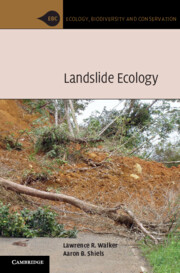2 - Spatial patterns
Published online by Cambridge University Press: 05 January 2013
Summary
Key points
Remote sensing tools have greatly improved the mapping of both terrestrial and submarine landslides, particularly at global scales. At regional and local scales, environmental correlates are being found that help interpret spatial patterns and related ecological processes on landslides.
Landslides are frequent on only 4% of the terrestrial landscape and coverage varies over time because new landslides do not occur at a constant rate.
Multiple landslides triggered by the same event, such as an earthquake or severe rainstorm, can vary in physical characteristics. This variety contributes to a mosaic of landslide conditions across the landscape.
A landslide environment contrasts with the more stable conditions found in adjacent habitats. The transitions between landslide and adjacent habitats in light, fertility, stability, and other characteristics can be abrupt to gradual, sometimes making it difficult to define where a landslide begins or ends.
Introduction
The distribution of landslides is determined by background factors (ultimate causes) such as rock type and soil properties and by immediate triggers (proximate causes) such as rainfall or earthquake occurrence (Dai et al., 2002). While the prediction of the location and timing of a particular landslide remains inexact, mapping of existing landslides at global spatial scales is improving with the use of remote sensing tools such as satellite imagery (Hong et al., 2007). There are also discernible spatial patterns at regional and local scales, driven particularly by the location of landslide triggers (e.g., earthquake epicenters, regions of high rainfall) interacting with topography (Zhou et al., 2002). Within a given landslide, there can also be spatial patterns that influence local ecological processes. The dramatic impacts that landslides have on plants, animals, and soils represent important alterations of the spatial patterns of many ecosystems that can influence future ecosystem processes for decades (Foster et al., 1998).
- Type
- Chapter
- Information
- Landslide Ecology , pp. 18 - 45Publisher: Cambridge University PressPrint publication year: 2012

